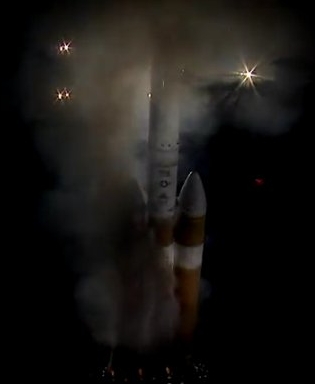BUMPED and revised to include the September 30th launch abort.
Can we count the ways? For what has become a string of seemingly endless technical issues, ULA on September 29th was forced to once again scrub the launch of a military reconnaissance satellite because of a technical issue with its Delta 4 Heavy rocket and launchpad.
Apparently when they tried to move the launchpad’s mobile gantry away from the rocket they discovered “a hydraulic leak in the ground system.”
On the evening of September 30th (tonight) they tried again, only to have an abort at T-7 seconds, just as the engines were to ignite as planned.
They have been trying to get this bird off the ground now for more than a month. Here is a chronology of the launch scrubs, with all the various technical issues described.
August 26: Scrub because of “several problems,” the primary cause being a “pneumatics system issue.” This same countdown also had a long hold because of two blown fuses in a launchpad heater.
August 29: Aborted at T-3 seconds, due to “a torn diaphragm in one of three pressure regulators” in the launchpad. During the countdown they also had holds to deal with a fuel valve issue, a fuel sensor issue, and a temperature payload issue.
September 26: Scrubbed because of issue with the launchpad “swing arm retraction system.”
September 27: Scrubbed because of a continuing issue with the launchpad “swing arm retraction system.”
September 29 (just after midnight): A lightning strike forced a scrub. This was the only scrub not caused by technical issues.
September 29 (just before midnight): Scrubbed because of a hydraulic leak in the ground system.
September 30: Aborted at T-7 seconds. Under investigation. No new launch date yet announced.
This string of seemingly minor and apparently easy-to-fix problems does not reflect well on the quality control systems at ULA. I understand that this is rocket science, and thus difficult. At the same time engineers have now been doing launches for more than a half century, and this tale of woe above is more reminiscent of the early days of rocketry in the 1960s, when you might have a dozen or more scrubs because of these kinds of technical issues. You’d think by now ULA’s launch engineers would have worked these kinks out.
From a customer perspective this list of issues is also troubling, considering that the Delta 4 Heavy costs the customer more than any other commercial rocket. Granted it can put up a lot of payload, but the Falcon Heavy can put up more, and do it for less than half the cost and far more reliably. If I was ULA’s customer I would not be very satisfied with the product I am getting, even if the launch turns out to be a complete success.
The delays are also impacting other launches. SpaceX has had to repeatedly delay the launch of a GPS satellite on its Falcon 9 because for scheduling reasons the ULA launch must come first.

